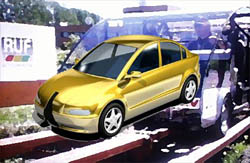RUF Idea On A Rail
By Bill Moore, Editor, EVWorld
[Originally posted at EV World,
reposted with permission]
The 'RUF' idea is you drive your short-range (30 mi.) electric vehicle to the nearest
monorail onramp. A electronic guide system buried under the roadway deftly steers your car
onto the monorail. Once you're on the rail, the car's automatic drive system engages and
you are whisked up more than 12 feet onto the main rail line, merging safely with other
traffic. Within a minute you are racing -- hands-free -- towards the center of town at 60
miles per hour as part of a "train" of six or seven other RUF-equipped Evs.
Until this past June, the Rapid Urban Flexible EV concept was only... well a concept. But
this summer RUF took a significant step forward when a prototype "mule" rolled
onto a 24 meter-long test track outside of Ballerup, Denmark. Looking nothing like the
sleek 1998 concept mockup that gave physical form to the idea or the more
conventional-looking Z-9 and Z-11 concept cars, the RUF mechanical test bed sports a clear
plastic canopy and a heavy steel tube frame. It boasts eight wheels: four normal road
wheels and four smaller track wheels hidden discretely along either side of the vehicle's
centerline. There are also separate steel drive wheels that propel the vehicle along the
guide rail.
Originally conceived of more than a decade ago, the RUF system is the brainchild of Danish
inventor Palle Jensen. Since the concept was first presented in 1988, Jensen has
successfully garnered the support of a number of major sponsors including three Danish
ministries (Energy, Environment, Education) and a number of multinational corporations
including Siemens, Hawker and Mannesmann, as well as a bevy of Danish firms.
What Jensen proposed and is finally seeing take shape is an electric vehicle that has a
v-shaped channel down its centerline. The vehicle drives onto the guide rail where its
four track wheels rest on supporting side tracks. The main road wheels no longer make
contact with the ground. A pair of drive wheels firmly clasp the guide rail, which is also
"hot" and provides the electricity to drive the test bed, as well as recharge
its battery. A rail brake stops the vehicle.
Jensen and his collaborators propose to create a system of elevated guide ways on which
thousands of RUF EVs, both publicly and/or privately owned would move commuters quickly 4
meters above street level. Essentially they envision a combination of monorail train and
autonomous electric vehicles which can be driven up to 30 miles before needing to be
recharged, either by parking on a side track or by being plugged into a charger similar to
a conventional EV.
The goal of the RUF system is to reduce congestion while overcoming some of the more
nagging problems confronting EVs such as short range and long recharge times.
According to RUF International's calculations, a single highway lane can accommodate a
maximum of 2,000 cars per hour per lane. By contrast, they say the RUF system could handle
as many as 3,600 vehicles per hour per rail. In addition, four rails can be installed in
the same space as three highway lanes, making it possible to move many more passengers
much more efficiently than our current system and with far less pollution and wasted
energy.
Jensen also proposes what he calls the Maxi-RUF, a ten-passenger vehicle that would use
the same track system, sort of electric mini-buses. As might be imagined, the RUF system
will also be heavily dependent on smart vehicle technology that automatically routes the
vehicle and directs its switching to other tracks. The driver/user simply programs into
the car where it is they want to go and the computer handles the rest. It will even
communicate with other vehicles to see if they are going to the same destination and
automatically form "trains" to increase traffic density and reduce energy usage
by "drafting".
Just as our current highway system is used for both passengers and cargo, automated cargo
carriers can also use the RUF system. Shipments could be dispatched from warehouses and
dropped at distribution points where EV "tractors" could pick them up for
deliveries to outlying stores and shops.
The roll-out of the test bed in Ballerup doesn't guarantee the RUF system will every reach
deployment, but the fact that some very serious "players" are participating in
the experiment bodes well.

Rapid Urban Flexible concept EV combines flexibility of individual automobile with
monorail train concept. Prototype "mule" passes first test in June, 2000.
RUF.DK Web Site
Additional Photos
Prototype
test vehicle on monorail track
Prototype test mule on
monorail track
Prototype test mule
Z11 concept vehicle
Z9 concept vehicle
Original RUF mockup
vehicle
RUF prototype monorail close-up